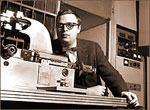EXCLUSIVE TELEVISION REVIEW:
New Orleans Music: The Secret Story Behind HBO's 'Treme'
Wednesday, June 22, 2011
Joel Selvin
Who cares about the dumb soap opera plot points? What keeps me coming back week after week to the HBO series 'Treme' is the insider's look at the New Orleans music scene. In 'What Is New Orleans,' the latest episode, the young jazz musician son of the cranky old Mardi Indian winces while his father shows New York jazz great Ron Carter how the bass part should go, right in the middle of Dr. Rudy Van Gelder's hallowed Hackensack, N.J. recording studios, as one of the musicians carefully notes. Dr. John scowls.
 That reference to Dr. Rudy Van Gelder may have been lost on most of the TV viewing public, but I sat up. I always wondered what the famed studio looked like. Visitors were never encouraged. You heard stories and, indeed, as seen on 'Treme,' the place looked like someone's Danish modern mid-century living room with expensive microphones. No inside dope on Dr. Van Gelder's secret microphone placement technique though. That reference to Dr. Rudy Van Gelder may have been lost on most of the TV viewing public, but I sat up. I always wondered what the famed studio looked like. Visitors were never encouraged. You heard stories and, indeed, as seen on 'Treme,' the place looked like someone's Danish modern mid-century living room with expensive microphones. No inside dope on Dr. Van Gelder's secret microphone placement technique though.
How many HBO subscribers read the small print on the back of '50s and '60s jazz albums by John Coltrane, Miles Davis, Sonny Rollins and anybody who was anybody in the world of jazz and would even recognize the reference? Even fewer would know what a glimpse inside a hidden garden 'Treme' was serving up.
Screenwriter George Pelicanos ' also a key figure in 'Treme' producer David Simon's previous HBO phenomenon, 'The Wire' ' brilliantly threads music through his own crime fiction; taut, gritty novels such as 'King Suckerman' or 'Hell To Pay,' largely set in the Washington D.C. ghetto in the 80s and knowledgably larded with soul music and punk rock of the era. His hand can be seen in the toughening crime angles in this season's criss-crossing narratives. The series is also trying hard to give a sweaty close-up to the kitchens of New York restaurants. A developer from Texas is also scooping up properties in the wake of Katrina and local politics are flickering through plotlines.
But, for me, it's the music wrinkle that keeps me coming back. It started early in the first season, when the lead musician character in the show's soap opera merry-go-round, trombone player Antoine Batiste (borrowing the last name of a very distinguished line of New Orleans musicians), was having problems with taking a job playing for drunken tourists on Bourbon Street and he runs into Trombone Shorty on the street who assures him it was cool for him to play Bourbon Street.
|